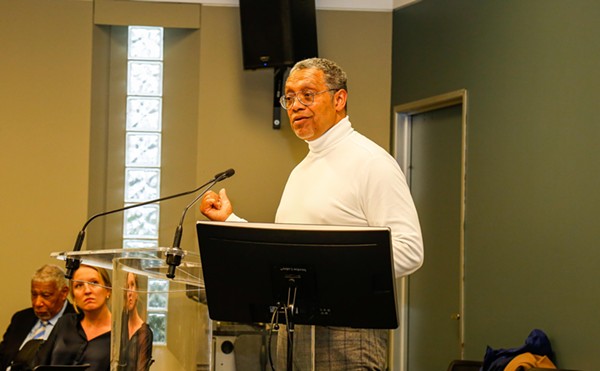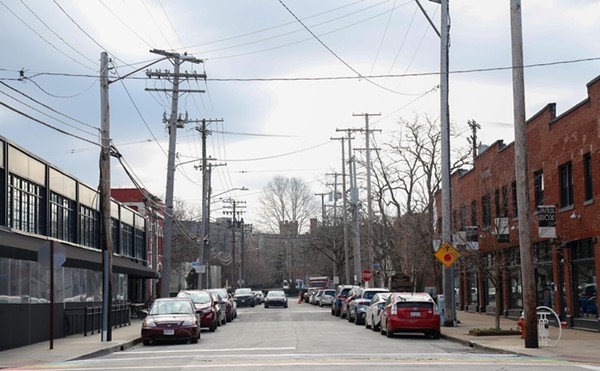Hell, the first time the thing was filled, its interior steel shell cracked. Uneven cooling, they said. Nothing of concern, they said.
Demand was skyrocketing, though, and that wasn't a surprise. Cleveland was a fulcrum for innovation as the U.S. marched into Europe and the Pacific. And at home, well, people needed gas like never before. Economically, East Ohio's developments made total sense. And the company's rapid-fire innovation came paired with assurances of security, of safety. But it's difficult to stop a machine once it's set in motion, especially one hitting on all cylinders.
Shortly after 2 p.m. on Oct. 20, 1944, as Marian Laska's lunch rush quieted, East Ohio workers checked the specs on each tank and dutifully approved whatever needed approval. No one would ever be able entirely to confirm the data, however; those guys would be swept off this plane within the hour.
The wind outside was picking up, but the weather remained fine.
The clock ticked dispassionately toward 48 seconds past 2:40 p.m. Neighbors and employees around the area would later report seeing a fine haze collecting at the base of the tanks. That would have been the leaked liquid gas vaporizing against the oxygen outside. That would have been the first and only sign that the whole galaxy was about to shift into a terrible new dimension. That would have looked awfully goddamned worrisome in the moment.
The promises of innovation and profit and energy security never mentioned the fact that a small river of liquid gas might one day escape into the air and the sewer lines and every open space imaginable and — you do understand how diffusion works, right?
The Cleveland Press' evening edition, thumping upon doorsteps even as the nightmare rolled onward hours later, told the whole story. But it would be decades before local writer John Stark Bellamy squared the tale so simply: "Only the pen of a Dante could do justice to the sights and sounds that occurred in the St. Clair-Norwood neighborhood that hellish afternoon."
***
Art Stroyer sees the fireball. Marian Laska feels the rumbling. The terror doesn't register immediately; neither of them are even sure what the hell any of it is, really. No one is. Everything happens instantly.
The sky blushes a grim red, a shade streaked violently with tawny ash and searing scraps of metal. The fireball can be seen from as far away as Chagrin Falls' bucolic farmland. The deep boom shakes Plain Dealer desks over on West Sixth and Rockwell. But immediately, homes lining East 61st and Lake Court and St. Clair and every road within a half-mile of those giant storage tanks are going up in flames.
Everything happens instantly.
Something ignites the fine white haze of vaporized gas — no one would ever be able to say what or how — and unrelenting fire rages outward in every direction. Up: The heavens are ablaze. Down: The sewer lines become the Styx, breathing death into homes that had been so peaceful and warm just seconds before. The accompanying sounds are unnatural.
Albert Kotnick, who's not unlike Marian Laska or Art Stroyer in his unbound wartime optimism, is heading out of his East 61st Street home when he feels, sees, becomes one with the Explosion — and, Jesus Almighty, was that really an Explosion? — and he runs back into house to get his two young children and his wife, and they're flying down the street, and as they're flying down the street the building that the Kotnick family has called home for years lights up in blazing oranges and yellows and hell-spawned reds and blacks. Within minutes, it's gone.
Are the Germans bombing Cleveland? What in god's name was that?
It's only in the microseconds between the realization that her face is burning and the realization that the walls of the Lamson & Sessions cafeteria are red with fire that Marian Laska even has time to consider what's going on. It's an impossibility. None of this adds up to a logical variable. Her manager ushers her out into the dark world, to some remote wish for safety.
Everything is burning — burning in the simplest sense imaginable. Flesh sears. Screams echo down alleyways and the burnt husks of Carry Avenue, East 62nd, careening between frantic mothers clutching babies and the dazed and delirious. Life savings — cash stored throughout homes, all of the money to a man's name — flare up in an instant. The suddenness of it all is otherworldly.
And just as suddenly, everyone is here. (The kids, thankfully, are still in schools all over the city and not really anywhere near the site.) But firefighters, police officers, reporters, photographers, butchers, printers, foremen, maintenance workers, auto repairmen, mothers, fathers, sons, daughters — they're all here. Watching. Wondering. Praying. Helping.
Amid thick smoke, flames lasso the afternoon sky at 2,800 feet. The wind, ebbing along at some 12 miles per hour, pushes fire down onto crowds of spectators lining St. Clair. "It was as if a flame-thrower had been turned on you," one man told the papers. Police work fast to cordon the area and get all the survivors south of St. Clair. "Get out before it's too late!" an officer's voice is booming through a microphone. The evacuation is under way startlingly quick, though men and women still walk through smoke in a daze.
Traffic is a real bitch right now, and ruptured culverts along St. Clair are steepling the roadway. Fire Engine No. 7 falls into a smoking crater. The earth is swallowing the neighborhood.
Art Stroyer has work to do. He works his car back to Bishop & Babcock and starts delegating tasks: Clear that flaming debris on the roof, change those sprinkler heads, get the hell outta here and stay safe. He finds a spare moment and calls his wife: "Did you hear about the Explosion?" Miles away, she hadn't. Art's gotta run, though, so he tells her he's okay and then he's back at it.
More and more people are gathering. Children are getting out of school. Manhole covers pop like corks and soar across red skies. One crashes down onto two men, adding injuries to the exponentially growing toll. There are people everywhere now. There are bodies everywhere now. How could this be happening?












